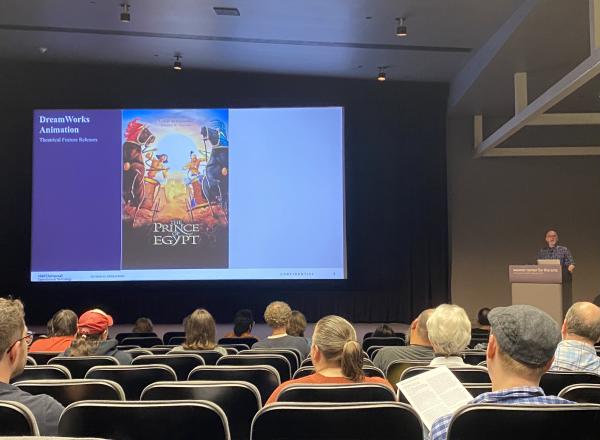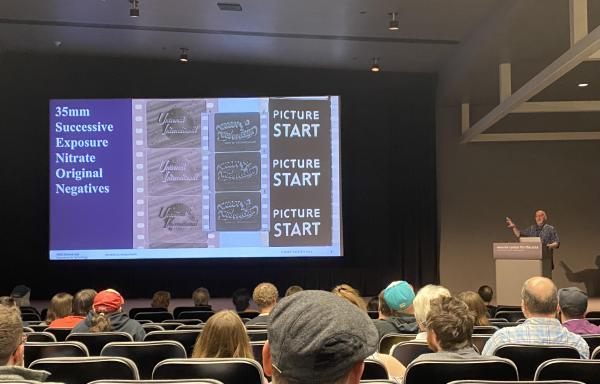Drawn Out History: Chase Schulte Speaks on DreamWorks and Film Restoration at Cartoon Crossroads Columbus

Animation as a medium has been around since the late 1800s, its humble beginnings evolving into an increasingly diverse range of beautifully crafted works spanning film and television alike. Animators have employed a variety of techniques to recreate motion through hand-drawn and digitally created figures, breathing life into otherwise static images. The work of countless artists has shaped the animation industry for over a century, and it is the job of archivists like Chase Schulte to preserve this legacy.
Chase Schulte, manager of Physical Archive Operations at NBCUniversal, has worked in the film industry for decades and has grown renowned for his work in film archivism through DreamWorks and NBCUniversal. A panelist for Cartoon Crossroads Columbus, Schulte presented on the history of DreamWorks Animation and animation restoration at Wexner Center for the Arts on September 28, 2023.
With the company’s 30th anniversary fast approaching, Schulte highlighted the hard work and effort of artists throughout the history of DreamWorks Animation LLC. DreamWorks SKG was founded in 1994, the SKG representing the initials of the dream team of creators behind the studio that included producer and director Steven Spielberg, former Disney executive Jeffrey Katzenberg, and music executive David Geffen. The three took on this risky venture out of a love for animation, forming a studio whose films would not only prove financially and critically successful, but also revolutionize the animation industry as we know it.
With the studio’s founding established, Schulte ran through each of the 44 theatrically released films and 56 television productions from DreamWorks Animation, pausing intermittently to discuss specific techniques and stories behind each project. For example, in 1998, Antz used cutting-edge CG animation technology while beginning the trend of celebrity voice casting. That same year, The Prince of Egypt created a cultural event that has since been translated into over 40 languages. Schulte fondly reminisced over the story of how Shrek's initial Las Vegas screening caused the room's temperature to rise from laughter to the point a key stakeholder excitedly exclaimed, "we got it."

Schulte is aware of the impression these films and shows have on audiences—each cheer from the mention of a fan favorite caused him to gladly elaborate on the passion behind each project and the cultural impact it has left behind. Oftentimes it is that fan response that drives creatives to keep telling these stories. Schulte shared, "It means a lot to creators to see how they are touching lives out there."
Following his discussion of DreamWorks, Schulte presented a panel on Animation Restoration at Universal Studios. He discussed his time at NBCUniversal working in animation restoration as well as the early days of animation that he and others seek to salvage and restore. Much of early animation was stored and copied onto nitrate film, a form that allowed for colors at depths near impossible to recreate, while also causing difficulties with long-term storage. Schulte often works with the archives of one of the animation greats, Walter Lantz, whose cast of iconic characters like Woody Woodpecker and Andy Panda paired with musical melodies in his coined "cartunes" are restored by teams working hard at NBCUniversal.
To demonstrate the rewards of this monumental effort, Schulte showed guests newly restored film of the 1939 animated short The Sleeping Princess. Decades later, the film has been restored to a near pristine condition, the vibrant colors brought about by the original nitrate film captured beautifully. This Walter Lantz short was received with uproarious applause, as was the demonstration reel Schulte provided over other ongoing restoration efforts, including the final season of the 1950s rendition of The Lone Ranger.

However, not all restorations are as successful as those demonstrated during this presentation. Schulte discussed what he refers to as the tears of an archivist, the times where restoration simply proves itself to be impossible given modern technology. The animation bubble burst of the 70s and 80s led many studios to sell off their properties to maintain viability, including all assets and original film reels. Much of these are stored across the world in assorted storehouses where the film has been improperly stored, leading to the development of vinegar that corrupts the film with time and leaves countless hours of media irretrievable.
All hope is not lost, however. Recent technological advancements involving PAL video masters have proved promising, and with every vinegar-infused film reel, new hauls are uncovered, each rich with decades of film and animation history. Schulte hopes further developments may even make the unsalvageable salvageable so that the work of past creators can continue to be experienced by modern audiences. These past creators worked hard to breathe life into these creations, turning simple drawings into movement for the purpose of storytelling in a tradition that continues through the present day.
Schulte reminds us of the love infused into animated works and calls on audiences to remember the process that goes into creating the beloved stories of their childhood.
